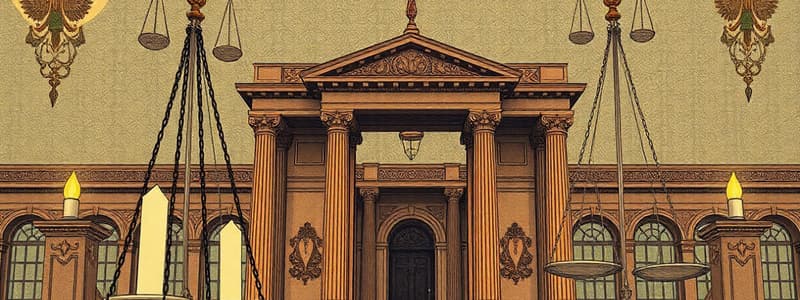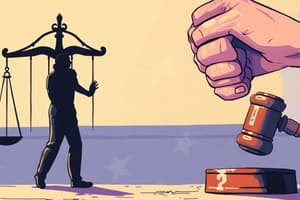Podcast
Questions and Answers
Match the following terms related to corrections with their definitions:
Match the following terms related to corrections with their definitions:
Electronic monitoring = A supervision strategy that uses electronic technology to track offenders. House arrest = Confined to their homes with electronic monitoring to ensure compliance. Shock probation = The practice of allowing inmates to apply for probationary release unexpectedly. Caseload = The number of probation or parole clients assigned to one officer for supervision.
Match the following types of confinement facilities with their descriptions:
Match the following types of confinement facilities with their descriptions:
Prison = A state or federal confinement facility with authority over adults. Industrial prison = A correctional model that utilizes the labor of inmates. Hawkins Act = Federal legislation restricting interstate commerce in prison-made goods. Work release program = A prison program allowing inmates temporary community release for job responsibilities.
Match the following correctional beliefs and principles with their descriptions:
Match the following correctional beliefs and principles with their descriptions:
Martinson's view = The belief that correctional treatment programs have little rehabilitative success. Total institution = An enclosed facility where inhabitants share all aspects of daily life. Technical violations = Failures to adhere to the specific terms of probation or parole. Community corrections = Alternatives to incarceration that involve supervision in the community.
Match the following parole and probation concepts with their definitions:
Match the following parole and probation concepts with their definitions:
Match the following correctional terms with their concepts:
Match the following correctional terms with their concepts:
Match the following terms related to juvenile and correctional systems:
Match the following terms related to juvenile and correctional systems:
Match the following aspects of electronic monitoring with their characteristics:
Match the following aspects of electronic monitoring with their characteristics:
Match the following roles in the correctional system with their responsibilities:
Match the following roles in the correctional system with their responsibilities:
Match the terms with their definitions regarding prison management:
Match the terms with their definitions regarding prison management:
Match the following correctional policies:
Match the following correctional policies:
Match the following legal terms with their definitions:
Match the following legal terms with their definitions:
Match the following terms with their definitions:
Match the following terms with their definitions:
Match the following inmate behaviors with their characteristics:
Match the following inmate behaviors with their characteristics:
Match the following concepts related to juvenile issues:
Match the following concepts related to juvenile issues:
Match the following juvenile justice terms with their descriptions:
Match the following juvenile justice terms with their descriptions:
Match the correctional terms with their descriptions:
Match the correctional terms with their descriptions:
Match the types of facilities with their characteristics:
Match the types of facilities with their characteristics:
Match the following legal terms with their definitions:
Match the following legal terms with their definitions:
Match the following characteristics with their definitions:
Match the following characteristics with their definitions:
Match the following classifications related to inmates:
Match the following classifications related to inmates:
Match the terms to their relevant roles or functions in the correctional field:
Match the terms to their relevant roles or functions in the correctional field:
Match the following juvenile justice concepts with their implications:
Match the following juvenile justice concepts with their implications:
Match the following definitions with their corresponding juvenile terms:
Match the following definitions with their corresponding juvenile terms:
Match the following acts or statuses with their descriptions:
Match the following acts or statuses with their descriptions:
Match the following legal concepts with their definitions:
Match the following legal concepts with their definitions:
Match the following terms related to crime and punishment:
Match the following terms related to crime and punishment:
Match the following definitions with their corresponding legal processes:
Match the following definitions with their corresponding legal processes:
Match the following criminal justice terms with their meanings:
Match the following criminal justice terms with their meanings:
Match the following types of bail with their explanations:
Match the following types of bail with their explanations:
Match the following terms related to judicial processes:
Match the following terms related to judicial processes:
Match the following sentencing goals with their descriptions:
Match the following sentencing goals with their descriptions:
Flashcards
Bail
Bail
The release of an accused person from custody, for all or part of the time before or during prosecution, on their promise to appear in court when required.
Initial Appearance
Initial Appearance
An appearance before a magistrate during which the legality of the defendant's arrest is initially assessed, and the defendant is informed of the charges.
Bail Bond
Bail Bond
A document guaranteeing the defendant's appearance in court and recording the pledge of money or property to be paid if they don't appear. It's signed by the person to be released and anyone acting on their behalf.
Real Property Bail
Real Property Bail
Signup and view all the flashcards
Danger to the Community Law
Danger to the Community Law
Signup and view all the flashcards
Sentencing
Sentencing
Signup and view all the flashcards
Incapacitation
Incapacitation
Signup and view all the flashcards
Retribution
Retribution
Signup and view all the flashcards
Electronic Monitoring
Electronic Monitoring
Signup and view all the flashcards
Industrial Prison Model
Industrial Prison Model
Signup and view all the flashcards
Hawes-Cooper Act
Hawes-Cooper Act
Signup and view all the flashcards
Nothing Works Doctrine
Nothing Works Doctrine
Signup and view all the flashcards
Caseload
Caseload
Signup and view all the flashcards
Prison
Prison
Signup and view all the flashcards
Work Release
Work Release
Signup and view all the flashcards
Shock Probation
Shock Probation
Signup and view all the flashcards
Juvenile Justice System
Juvenile Justice System
Signup and view all the flashcards
Parens Patriae
Parens Patriae
Signup and view all the flashcards
Just Deserts Model
Just Deserts Model
Signup and view all the flashcards
Design Capacity
Design Capacity
Signup and view all the flashcards
Operational Capacity
Operational Capacity
Signup and view all the flashcards
Rated Capacity
Rated Capacity
Signup and view all the flashcards
Selective Incapacitation
Selective Incapacitation
Signup and view all the flashcards
Custody Level Classification
Custody Level Classification
Signup and view all the flashcards
Hands-off Doctrine
Hands-off Doctrine
Signup and view all the flashcards
Inmate Grievance Procedure
Inmate Grievance Procedure
Signup and view all the flashcards
Blackness
Blackness
Signup and view all the flashcards
Dual System Youth
Dual System Youth
Signup and view all the flashcards
Status Offense
Status Offense
Signup and view all the flashcards
Abused Child
Abused Child
Signup and view all the flashcards
Beyond Parental Control
Beyond Parental Control
Signup and view all the flashcards
Juvenile Delinquency
Juvenile Delinquency
Signup and view all the flashcards
Study Notes
Criminal Justice Systems
- Release of Accused: Release from custody, temporarily or permanently, before or during prosecution, possibly by promising court appearance.
- Initial Court Appearance: Defendant's first appearance before a magistrate where the legality of the arrest is assessed and charges are presented.
- Bail: A promise or pledge of money or property to ensure a defendant's appearance in court. This can be tied to land, houses, stocks or other assets.
- Preventive Detention: To stop a defendant from causing harm to other people in society, prohibiting release before trial.
- Criminal Sanction: A penalty imposed judicially, potentially including imprisonment.
- Deterrence: Punishment, or threat of punishment, intended to discourage future criminal activity.
- Retaliation: Act of revenge against a criminal.
- Recidivism: Returning to criminal behavior after sanctions or interventions.
- Restorative Justice: A sentencing goal aiming to repair harm to victims and the community caused by the crime.
- Specialized Courts: Courts focused on specific problem areas like drug abuse or re-entering the community after incarceration to aid in rehabilitation.
- Electronic Monitoring: Using technology to track offenders, usually as a condition of house arrest or parole, to ensure adherence to rules.
- Home Confinement: Offenders are electronically monitored and restricted to their homes and surroundings.
- Shock Probation: A probationary release from prison, offering a possibility of being released early.
- Probation/Parole: Options for supervision and monitoring after release from prison, aimed at integrating the offender, back into society.
- Custodial Authority: State or federal confinement facilities for adults, which have the authority over incarcerated individuals.
- Correctional Models: Different methods of managing criminals including industrial prisons and work programs
- Prison Legislation: For example the 1935 legislation, where interstate commerce in prison-made goods was regulated.
- Prison Programs: Programs for offenders where the aim is to support reintegration and success in the community.
- Inmate Populations: Physical structures and policies for managing inmates.
- Inmate Groups: Gang activities and safety concerns in prison.
- Prison Management Policies: Policies and procedures that govern the operation of prisons, especially the earlier 1960s approach.
- Juvenile Court Complaints: Legal documents filed in juvenile court, bringing claims against a juvenile offender, relating to conduct.
- Juvenile Delinquency: Action or misconduct of a minor that is considered criminal according to the law.
- Juvenile Status Offenses: Actions that are illegal only if committed by a minor.
- Parental Custody of Minors: Laws that permit the state to assume the responsibility of a child, either because one parent is unable to care, or a child is deemed a threat or a danger to themselves or others.
- Imposition of Imprisonment: The act of a court putting someone in prison based on a legal decision.
- Contemporary Imprisonment Models: Modern approaches to criminal confinement.
- Prison Capacity Considerations: Factors influencing how many inmates a prison can effectively hold.
- Security-Based Imprisonment: Management based on the goal of protecting society from a criminal.
- Correctional Facility Operations: Prison facility operations, both administrative and physical, including management of inmates.
- Private Prisons: Movement toward the use of private facilities for incarceration.
- Negotiated Plea Agreements: Agreements among defendants, prosecutors, and courts, specifying terms of punishment in exchange for a guilty plea.
- Criminal Procedure: Rules of evidence, court decisions and judgements that impact legal decision-making.
- Criminal Sanction Imposition: The act of a court imposing a particular sanction on an accused.
Studying That Suits You
Use AI to generate personalized quizzes and flashcards to suit your learning preferences.




